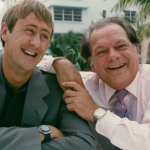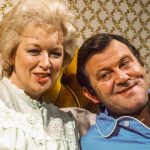Peter Butterworth, best known for his roles in the iconic Carry On films, led a clandestine life of heroism during World War II that has only recently come to light. Unearthed details from the National Archives reveal Lieutenant Butterworth’s pivotal role in the planning and execution of the Great Escape from Stalag Luft III, a story so remarkable that it served as the inspiration for the classic film ‘The Great Escape’ starring Steve McQueen.
Amid his fame for playing bumbling characters on screen, Butterworth’s wartime exploits remained hidden until researchers delved into the National Archives. Lieutenant Peter Butterworth, held as a prisoner of war, played a crucial role in orchestrating the famous escape from the Nazi POW camp on March 24, 1944. Surprisingly, he was supposed to be the last man in the tunnel but chose to stay behind. The reason was possibly to continue his vital coding work for British intelligence.
Butterworth’s involvement in coded messaging was revealed through an archived list of ‘Code Letter Writers’ at Stalag Luft III. Prisoners, including Butterworth, cleverly hid military intelligence in seemingly innocent letters to loved ones. As a matter of fact, they were passing on information about enemy ammunition dumps and more. Dr. Will Butler of the National Archives remarked, “Afterwards, because of the executions, escape attempts were halted, so his incredibly complicated coded messages were the only means of getting vital information back to London.”


War Hero To Carry On Star
The complexity of Butterworth’s code remained a mystery for over 70 years until a team from Plymouth University deciphered it. These revelations emerged during research for an exhibition and bookmarking the 80th anniversary of the Great Escape immortalised in the 1963 film featuring Steve McQueen and Richard Attenborough.
Butterworth’s wartime contributions extended beyond coded messages. A talented artist and skilled forger of documents, he played a significant role in the camp theatre. He would use this as a cover to hide soil from tunnelling activities. His artistic abilities and persuasive charm, alongside another British officer Talbot ‘Tolly’ Rothwell, even led the Germans to allow the construction of the camp theatre for prisoners’ entertainment.
Despite his war heroics, Peter Butterworth’s career achievements are primarily known for his comedic roles in the Carry On films. Dr. Butler expressed surprise at discovering Butterworth in camp theatre photos, emphasising his diverse talents. “He was a talented artist and is noted in the camp records as a very highly skilled forger of documents.”
Peter Butterworth’s wartime journey began when serving in the Royal Navy Fleet Air Arm, he was shot down in 1940. Initially imprisoned near Frankfurt, he escaped with 17 others in 1941, using soup spoons to dig a tunnel.

Peter Butterworth Turned Down For Playing Himself
Despite his remarkable contributions, Butterworth faced rejection in the film industry. He was famously turned down for role-playing himself in the 1950 film ‘The Wooden Horse’. Surprisingly, the casting director deemed him “too fat” and not “convincingly heroic or athletic enough.”
Peter Butterworth’s story sheds light on the unsung heroes behind the glamour of film and comedy. His son, Tyler, commented, “People had no idea this bumbling man had this incredible war story.”





